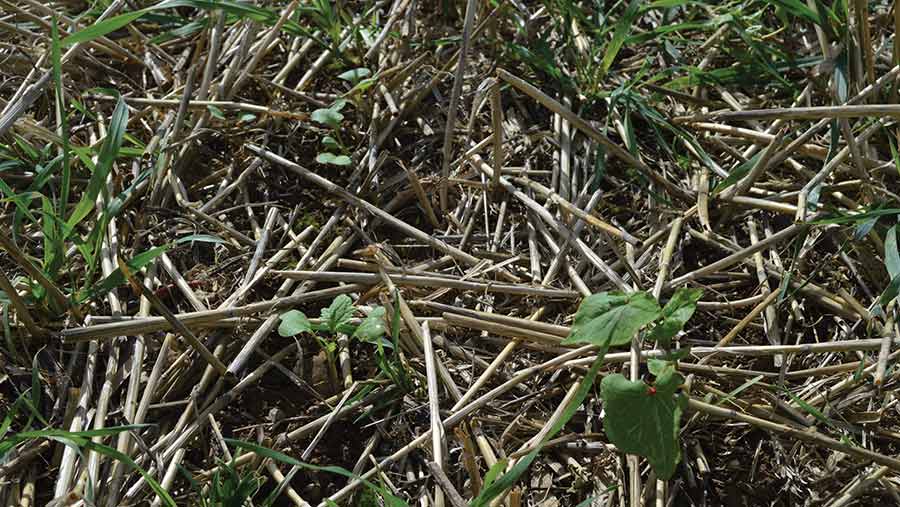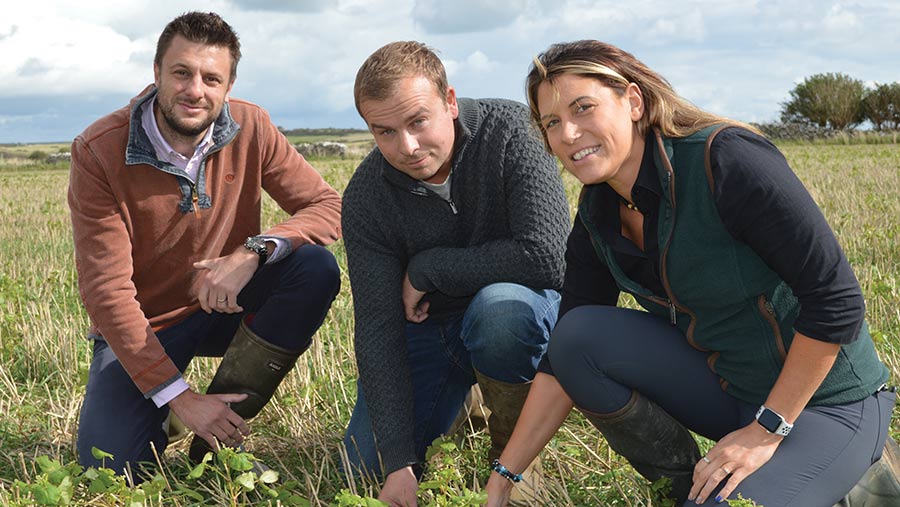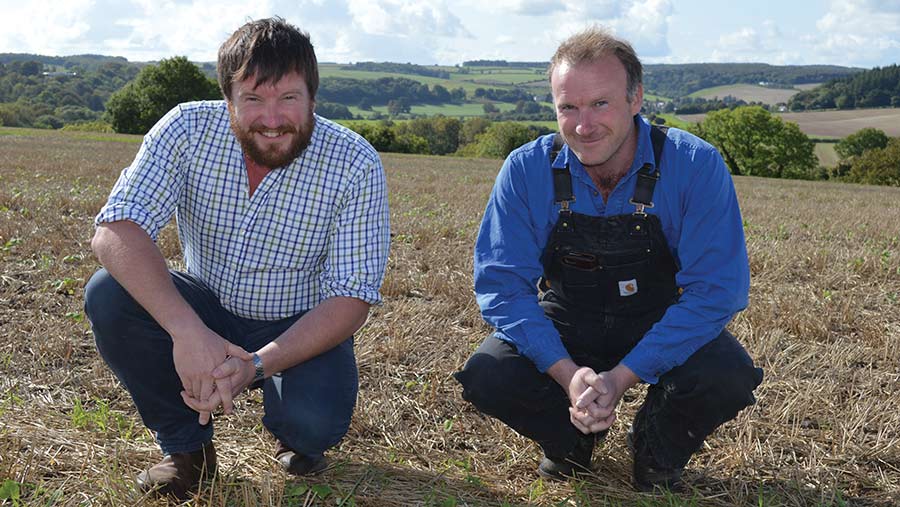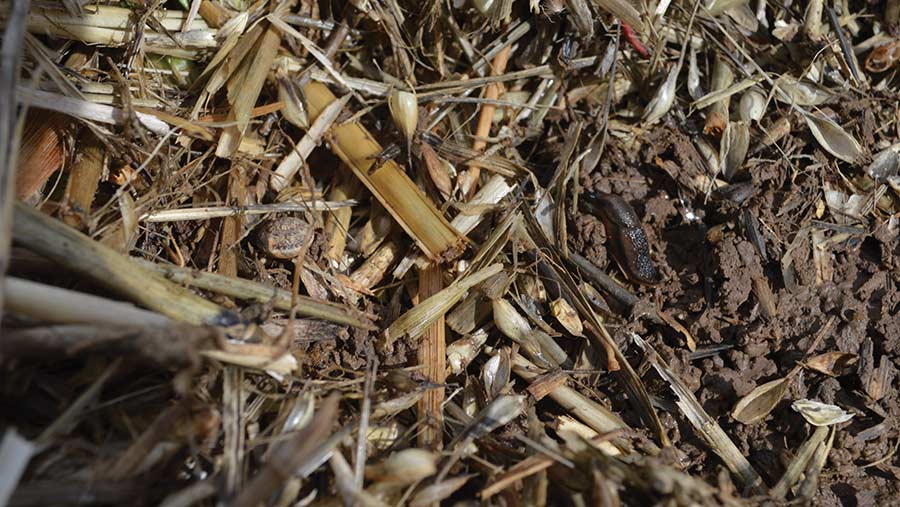Grower moves to direct-drilled OSR and companion crops
 OSR plant with buckwheat companion © MAG/David Jones
OSR plant with buckwheat companion © MAG/David Jones Dorset grower Andrew Fry is growing oilseed rape for the first time and is hoping for a good yield from his new break crop.
There is also £100/ha of government financial support for using a companion crop and no insecticides.
His OSR crop, grown close to Dorset’s famous Jurassic Coast, replaces winter beans, which suffered from low yields and salt burn from the nearby sea.
He hopes growing rapeseed will allow him better control of grassweeds.
This season, he has moved to direct drilling and his buckwheat companion crop has raced away after sowing.
This will help protect his young rapeseed crop, drilled two weeks later, from cabbage stem flea beetles in his new low-input establishment regime.
The aim is to spend only on buckwheat, rapeseed, fertiliser and slug pellets, and then start applying expensive herbicides once the crop is established by October under a cover of buckwheat and wheat volunteers.
“I am very impressed with the vigour of the buckwheat, which quickly produced a lot of leaves, and we have not seen any sign of flea beetle damage in the crop so far,” he says.
See also: OSR makes a comeback with new drill and companion crop
South coast
His family-operated Westhill Farm runs along the coastal cliffs of Dorset just south of Corfe Castle, near the village of Kingston.
It has 240ha in arable crops out of 600ha of land farmed, with the rest in grassland for beef cattle and sheep.
Andrew had been using minimum tillage before switching to strip tillage in the past four years.
This year he bought a new direct drill to fit in with his aims of improving his heavy brashy limestone soils and controlling grassweeds.
He replaced his poor-yielding winter beans with 42ha of direct-drilled oilseed rape this summer.
This has resulted in good soil moisture retention for his emerging rapeseed crop and avoided bringing up buried grassweed seeds.
An added bonus is the £55/ha he hopes to gain from using a companion crop and the £45/ha from not using any insecticides under the new 2023 Sustainable Farming Incentive (SFI).
Flea beetle threat
His oilseed rape crop followed winter wheat, which was harvested in the first week of August.
The wheat straw was chopped and the stubble left high to help hide the young emerging oilseed rape plants from flea beetles.
The land was drilled with the buckwheat variety Lifago on 20 August after a glyphosate spray. He used his newly purchased Weaving GD 6m disc direct drill at a seed rate of 10kg/ha, costing £15-£20/ha in seed.
Buckwheat establishes quickly and is then killed off with the first frosts of winter.
The oilseed rape was drilled in early September with the same drill at a rate to give 50 seeds/sq m when the buckwheat was 50-75mm high, after the ground had been broadcast with di-ammonium phosphate (DAP) fertiliser to provide 30kg/ha of nitrogen and some phosphate.
No pre-emergence herbicides were used.
Todd Jex, agronomist at advisory group Agrii, says the key to this establishment method is to use a direct drill, leave long stubble and drill the buckwheat before the rapeseed to provide a ready-made protective canopy to ward off flea beetles.

Todd Jex, Andrew Fry and Jazz Jex © MAG/David Jones
Peak migration
When drilling a crop slightly later, in early September, growers are able to avoid the peak flea beetle migration period of late August/early September, so fewer adult beetles find the crop when it emerges in mid- to late September .
This means there is less crop damage and fewer larvae than in crops sown much earlier.
“It is important to make sure you have a well-established crop before starting to apply autumn herbicides.
“I’d much rather have a late-drilled crop if you have to eventually abandon the crop, as the money spent is much less than for an early-drilled one,” he adds.
Andrew says there was some slug grazing of the buckwheat, so this gave him an early warning to use slug pellets. He applied 5kg/ha of ferric phosphate pellets with the drill and then a further 5kg/ha later.
The rapeseed variety used was the hybrid Exsteel, which shows fast early development and good disease resistance, says Jazz Jex, Agrii agronomist, trials co-ordinator and Todd’s sister.
“The variety shows good speed of development, which means it grows quickly and so fits in well with the late drilling slot,” she adds.
Andrew is pleased with the performance of the crop so far this season, and he and Todd are looking for the rapeseed to yield more than 3.5t/ha, with any SFI payments being an added bonus.
The farm used no insecticides last season and saw a big increase in ladybird larvae at 2023 harvest.
The resulting SFI payments will help cover the extra cost of the buckwheat seed and having to drill twice. Increasing flea beetle resistance to pyrethroids also makes insecticide spraying more questionable.
Looking ahead, clethodim (Centurion Max) is likely to be used to give control of blackgrass, and then propyzamide (Kerb) later to boost blackgrass and grassweed control.
No-insecticide farm favours companion crops
Brothers Tom and Will Taylor have not used any insecticides on their Dorset family farm for nearly a decade, so they were attracted to the method of using a companion crop and no insecticides to establish oilseed rape.
Yields had suffered in the past from flea beetles, slug damage and running a tight rotation, so the Taylors have pushed the oilseed rape into a longer rotation on their light loam soils over chalk.
The farm has been direct drilling for many years, and two years ago the brothers switched to a 6m Weaving DG drill, similar to Andrew Fry’s, and they were attracted to the financial benefits of entering the 2023 Sustainable Farming Incentive (SFI).
“The SFI was a useful consideration when growing oilseed rape, as we have not used insecticides on the farm for nearly 10 years,” says Tom.

Will and Tom Taylor © MAG/David Jones
Following barley
Their 120ha oilseed rape crop was following spring barley and they left a long stubble when the barley was cut in the second week of August, and then the straw was baled and carted away.
After glyphosate, the buckwheat was direct-drilled at the end of August at 10kg/ha and the land rolled.
When the buckwheat was 25-50mm high, the oilseed rape variety Exsteel was drilled on 13 September at 50 seeds/sq m along with DAP fertiliser.
The flea beetles did start feeding on some buckwheat, but it is generally unpalatable to the pest.
“There is no real armoury against flea beetles, so this system looked attractive for us to use,” says Will, adding that flea beetles are becoming more resistant to the pyrethroid insecticides that are often used for control.
Although farming light soils at Hammett’s Farm, between Pimperne and Blandford Forum, the Taylors did see slug damage to the emerging rapeseed crop, so slug pellets were applied soon after drilling.
Beetle and larvae damage
Todd emphasises that the later drilling allows oilseed rape to emerge after the main flea beetle migration period, so there is less autumn damage and a lower risk of the adults laying eggs to cause larvae damage.
In his group’s trials, September-drilled oilseed rape has on average outyielded earlier drilled crops across central and southern England, but he does point out this later drilling is more problematic further north due to short autumns and the early onset of winter.
One concern from this establishment method is slug damage, because, as Todd points out, there is more vegetation due to buckwheat and cereal volunteers.
The farm will probably use a graminicide such as propaquizafop (Shogun) to control barley volunteers and then either Kerb or AstroKerb (propyzamide + aminopyralid) later depending on the weed spectrum.

Snail and slug damage © MAG/David Jones

